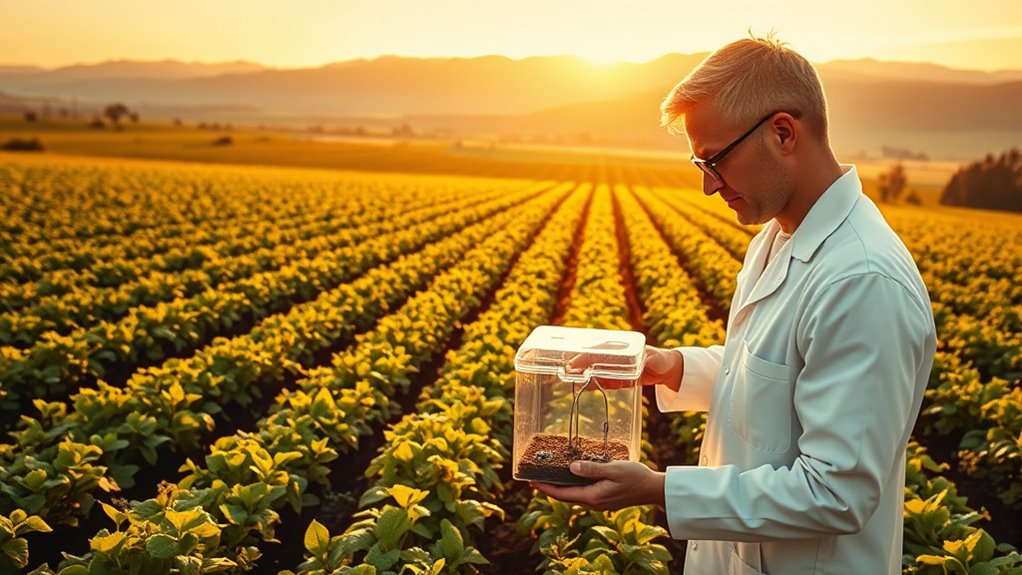Genetic engineering, especially using CRISPR, allows you to develop crops that can withstand extreme weather like droughts, floods, and heat waves. These climate-resistant varieties help secure food supplies and reduce reliance on chemicals, supporting sustainable farming. While the technology offers quick, precise improvements, ethical and ecological questions remain. If you want to understand how these innovations balance sustainability and responsibility, keep exploring the ways science is shaping future agriculture.
Key Takeaways
- Gene editing tools like CRISPR enable precise development of crops resilient to drought, floods, heat, and pests.
- Climate-resistant crops can stabilize yields and reduce reliance on chemical inputs, supporting sustainable agriculture.
- Ethical considerations include ecological impacts, gene flow risks, and equitable access to gene editing technologies.
- Regulatory frameworks and public acceptance are critical factors in deploying genetically engineered climate-resistant crops.
- Integrating gene editing into climate adaptation strategies requires responsible oversight and collaboration among stakeholders.

As climate change accelerates, developing crops that can withstand extreme weather conditions becomes more urgent. You’re at the forefront of a scientific revolution that could reshape agriculture and help feed a growing global population. Gene editing technologies, like CRISPR, offer powerful tools to enhance crop resilience, but they also raise important questions about gene editing ethics. Before deploying these innovations, it’s essential to consider not just the scientific potential but also the moral implications, such as unintended consequences, ecological impacts, and equitable access. Balancing innovation with responsibility ensures that crop resilience strategies are sustainable and ethically sound.
When you focus on gene editing ethics, you’re addressing concerns about manipulating plant genomes. Critics worry about unforeseen effects, gene flow to wild relatives, and the long-term stability of edited traits. As you develop climate-resistant crops, it’s imperative to weigh these ethical considerations alongside scientific benefits. Transparency and rigorous testing become essential components of responsible innovation. You need to guarantee that edited crops do not compromise biodiversity or create dependencies on specific biotech companies. Engaging with regulators, scientists, and farmers helps foster trust and ensures that crop resilience strategies are implemented thoughtfully.
Your efforts in engineering climate-resistant crops involve selecting traits that enable plants to endure drought, flood, heat, and pests. These traits can be introduced more precisely through gene editing, reducing the time and resources needed compared to traditional breeding. As you modify crops, you’re also contributing to a broader strategy to adapt agriculture to changing climate patterns. These crop resilience strategies aim to stabilize yields, reduce reliance on chemical inputs, and minimize environmental impact. The goal isn’t just to survive current climate challenges but to thrive amid future uncertainties.
However, integrating gene editing into mainstream agriculture isn’t without challenges. Public acceptance depends on transparent communication about the safety and benefits of gene-edited crops. You must also consider regulatory frameworks that vary globally, which can either facilitate or hinder the deployment of resilient crops. Ensuring equitable access to these innovations is equally important; otherwise, disparities could widen between developed and developing regions.
Ultimately, your work in genetic engineering for climate-resistant crops is a balancing act—harnessing the power of science while respecting ethical boundaries. By developing robust crop resilience strategies and addressing gene editing ethics head-on, you’re helping to create a more sustainable, secure food future. This effort requires collaboration, careful oversight, and an unwavering commitment to responsible innovation, guaranteeing that the benefits of genetic engineering reach everyone without compromising ecological or ethical standards.
Frequently Asked Questions
How Does Genetic Engineering Differ From Traditional Breeding Methods?
Genetic engineering differs from traditional breeding because you directly transfer specific genes to develop desired traits, a process called gene transfer. Unlike traditional breeding, which relies on selecting and crossing plants over generations, genetic engineering speeds up trait selection by inserting genes precisely. This method allows you to target specific characteristics, such as climate resistance, more efficiently and accurately, reducing the time needed to develop improved crops.
Are Climate-Resistant Crops Safe for Human Consumption and the Environment?
You can feel confident that climate-resistant crops are generally safe for human consumption and the environment. For example, a genetically engineered drought-tolerant maize has been extensively tested, showing minimal biosafety concerns. While ecological impacts are carefully studied, ongoing research indicates these crops don’t harm biodiversity or soil health. Still, it’s essential to persist in monitoring to guarantee safety and address any potential biosafety concerns as these crops become more widespread.
What Are the Regulatory Challenges for Deploying Genetically Engineered Crops Globally?
You face significant regulatory challenges when deploying genetically engineered crops globally. International approval processes can be complex, requiring compliance with diverse countries’ safety standards and policies. Additionally, intellectual property rights may limit access and distribution, creating legal barriers. Managing these hurdles demands careful planning, collaboration with regulatory agencies, and understanding each region’s specific requirements to guarantee successful and responsible deployment of climate-resistant crops worldwide.
How Cost-Effective Is Developing Climate-Resistant Genetically Modified Crops?
Developing climate-resistant genetically modified crops can be quite cost-effective when you carefully analyze costs and weigh investment risks. You’ll find that initial research and development expenses are high, but long-term benefits like increased yields and reduced input costs make it worthwhile. By conducting thorough cost analysis, you minimize risks, ensuring that your investment pays off. Overall, strategic planning helps you balance costs and benefits for sustainable crop solutions.
Can Genetic Engineering Help Address Food Security in Developing Countries?
Imagine you’re in the early 20th century, and genetic engineering becomes your latest “Miracle on 34th Street.” You can see how it helps address food security by boosting farmer adoption of climate-resistant crops, leading to increased crop yields. This technology empowers farmers in developing countries to withstand droughts, floods, and pests, ensuring more stable food supplies. With your support, genetic engineering could be a game-changer for global hunger.
Conclusion
You might think genetic engineering is risky, but it offers a real chance to protect crops from climate change’s worst effects. By developing climate-resistant varieties, you can help guarantee food security for future generations. It’s not about replacing traditional farming but enhancing it. Embracing these innovations means you’re actively participating in a sustainable solution, giving you hope that we can adapt and thrive despite the changing climate.









